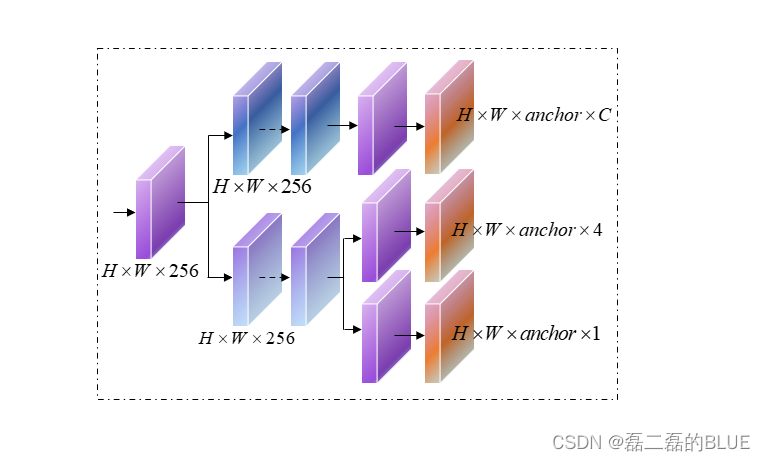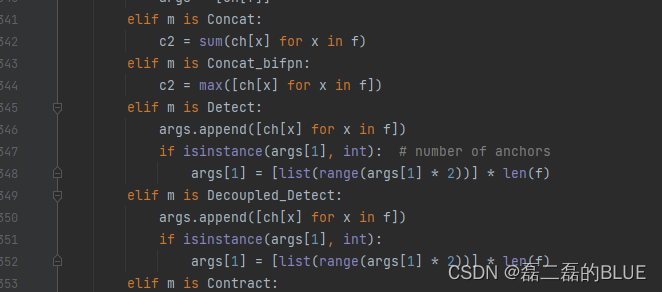YOLO v5 引入解耦头部
- 最近想开个 深度学习模型搭建, opencv方面的训练营,有兴趣可以私聊我
文章目录
前言
在 YOLO x中,使用了解耦头部的方法,从而加快网络收敛速度和提高精度,因此解耦头被广泛应用于目标检测算法任务中。因此也想在YOLO v5的检测头部引入了解耦头部的方法,从而来提高检测精度和加快网络收敛,但这里与 YOLO x 解耦头部使用的检测方法稍微不同,在YOLO v5中引入的解耦头部依旧还是基于 anchor 检测的方法。
一、解耦头部示意图
在YOLO x中,使用了解耦头部的方法,具体论文请参考:https://arxiv.org/pdf/2107.08430.pdf
于是按照论文中的介绍就可以简单的画出解耦头部,在YOLO v5中引入的解耦头部最终还是基于 anchor 检测的方法。
二、在YOLO v5 中引入解耦头部
1.修改common.py文件
在common.py文件中加入以下代码。
class DecoupledHead(nn.Module):
def __init__(self, ch=256, nc=80, anchors=()):super().__init__()
self.nc = nc # number of classes
self.nl =len(anchors) # number of detection layers
self.na =len(anchors[0])// 2 # number of anchors
self.merge =Conv(ch,256,1,1)
self.cls_convs1 =Conv(256,256,3,1,1)
self.cls_convs2 =Conv(256,256,3,1,1)
self.reg_convs1 =Conv(256,256,3,1,1)
self.reg_convs2 =Conv(256,256,3,1,1)
self.cls_preds = nn.Conv2d(256, self.nc * self.na,1)
self.reg_preds = nn.Conv2d(256,4* self.na,1)
self.obj_preds = nn.Conv2d(256,1* self.na,1)
def forward(self, x):
x = self.merge(x)
x1 = self.cls_convs1(x)
x1 = self.cls_convs2(x1)
x1 = self.cls_preds(x1)
x2 = self.reg_convs1(x)
x2 = self.reg_convs2(x2)
x21 = self.reg_preds(x2)
x22 = self.obj_preds(x2)
out = torch.cat([x21, x22, x1],1)return out
2.修改yolo.py文件
修改后common.py文件后,需要修改yolo.py文件,主要修改两个部分:
1.在model函数,只需修改一句代码,修改后如下:
ifisinstance(m, Detect) or isinstance(m, Decoupled_Detect):
2.在parse_model函数中,修改后代码如下:
3.在yolo.py增加Decoupled_Detect代码
class Decoupled_Detect(nn.Module):
stride = None # strides computed during build
onnx_dynamic = False # ONNX export parameter
export = False # export mode
def __init__(self, nc=80, anchors=(), ch=(), inplace=True): # detection layer
super().__init__()
self.nc = nc # number of classes
self.no = nc +5 # number of outputs per anchor
self.nl =len(anchors) # number of detection layers
self.na =len(anchors[0])// 2 # number of anchors
self.grid =[torch.zeros(1)]* self.nl # init grid
self.anchor_grid =[torch.zeros(1)]* self.nl # init anchor grid
self.register_buffer('anchors', torch.tensor(anchors).float().view(self.nl,-1,2)) # shape(nl,na,2)
self.m = nn.ModuleList(DecoupledHead(x, nc, anchors)for x in ch)
self.inplace = inplace # use in-place ops(e.g. slice assignment)
def forward(self, x):
z =[] # inference output
for i in range(self.nl):
x[i]= self.m[i](x[i]) # conv
bs, _, ny, nx = x[i].shape # x(bs,255,20,20) to x(bs,3,20,20,85)
x[i]= x[i].view(bs, self.na, self.no, ny, nx).permute(0,1,3,4,2).contiguous()if not self.training: # inference
if self.onnx_dynamic or self.grid[i].shape[2:4]!= x[i].shape[2:4]:
self.grid[i], self.anchor_grid[i]= self._make_grid(nx, ny, i)
y = x[i].sigmoid()if self.inplace:
y[...,0:2]=(y[...,0:2]*2+ self.grid[i])* self.stride[i] # xy
y[...,2:4]=(y[...,2:4]*2)**2* self.anchor_grid[i] # wh
else: # for YOLOv5 on AWS Inferentia https://github.com/ultralytics/yolov5/pull/2953
xy, wh, conf = y.split((2,2, self.nc +1),4) # y.tensor_split((2,4,5),4) # torch 1.8.0
xy =(xy *2+ self.grid[i])* self.stride[i] # xy
wh =(wh *2)**2* self.anchor_grid[i] # wh
y = torch.cat((xy, wh, conf),4)
z.append(y.view(bs,-1, self.no))return x if self.training else(torch.cat(z,1),)if self.export else(torch.cat(z,1), x)
def _make_grid(self, nx=20, ny=20, i=0):
d = self.anchors[i].device
t = self.anchors[i].dtype
shape =1, self.na, ny, nx,2 # grid shape
y, x = torch.arange(ny, device=d, dtype=t), torch.arange(nx, device=d, dtype=t)ifcheck_version(torch.__version__,'1.10.0'): # torch>=1.10.0 meshgrid workaround for torch>=0.7 compatibility
yv, xv = torch.meshgrid(y, x, indexing='ij')else:
yv, xv = torch.meshgrid(y, x)
grid = torch.stack((xv, yv),2).expand(shape)-0.5 # add grid offset, i.e. y =2.0* x -0.5
anchor_grid =(self.anchors[i]* self.stride[i]).view((1, self.na,1,1,2)).expand(shape)return grid, anchor_grid
3.在model函数中,修改Build strides, anchors部分代码,修改后代码如下:
#Build strides, anchors
m = self.model[-1] # Detect()ifisinstance(m, Detect) or isinstance(m, Decoupled_Detect):
s =256 # 2x min stride
m.inplace = self.inplace
m.stride = torch.tensor([s / x.shape[-2]for x in self.forward(torch.zeros(1, ch, s, s))]) # forward
check_anchor_order(m) # must be in pixel-space(not grid-space)
m.anchors /= m.stride.view(-1,1,1)
self.stride = m.stride
#self._initialize_biases() # only run once
try :
self._initialize_biases() # only run once
LOGGER.info('initialize_biases done')
except :
LOGGER.info('decoupled no biase ')initialize_weights(self)
self.info()
LOGGER.info('')
3.修改模型的yaml文件
在模型的yaml文件中,修改最后一层检测的头的结构,我修改yolo v5s模型的最后一层检测结构如下:
[[17,20,23],1, Decoupled_Detect,[nc, anchors]], # Detect(P3, P4, P5)
总结
至于单独的增加解耦头部,我还没有对自己的数据集进行单独的训练,一般都是解耦头部和其他模型结合在一起进行训练,如果后期在训练的时候map有提升的话,我在把实验结果放在上面,最近也在跑实验结果对比。
版权归原作者 小啊磊_Runing 所有, 如有侵权,请联系我们删除。